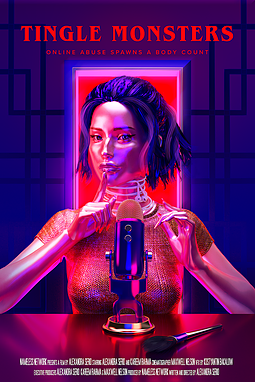ASMR short “Tingle Monsters” is a chilling slice of internet horror with an important message6/24/2020 Originally published on Elements of Madness For those who enjoy the soft whispering, feather-like brushing, and light tapping of ASMR videos, the idea of “ASMR horror” may be especially unsettling. Horror works extremely well when it invades our safe spaces, and directors often succeed by setting their horror films in places where we don’t expect to be scared. However, for those who find ASMR annoying or even anger-inducing, this popular internet sensation may create horror all by itself. If you’re in this second category, you may find yourself yanking off your headphones or muting your device while watching Alexandra Serio’s new short, Tingle Monsters, an ASMR horror film. Shot like a livestream, the 10-minute film is a creative and original piece that speaks to both online sexual terror and the dangers of the internet in general. ASMR, or Autonomous Sensory Meridian Response, is a calm and/or euphoric tingling in the back of the head and neck brought on by specific sounds or visuals. In recent years, it has become a popular internet trend with YouTube channels and other social media accounts dedicated to producing ASMR content. For many, these videos help with problems like anxiety and insomnia. The sensation is subjective, however, and some are not affected by ASMR videos at all while others actually experience anger and a fight-or-flight response. In Tingle Monsters, Serio (who wrote, directed, and acted in the short) plays an ASMR content creator named Dee. The short is filmed as one of Dee’s livestreams, which includes a live chat that blows up with comments as Dee’s devoted viewers chime in for their daily dose of tingles. However, it doesn’t take long before the comments take a dark and hateful turn, foreshadowing the real horror to come. Tingle Monsters doesn’t have to do much to get and keep our attention, especially considering how short it is. It makes its point quickly, and the unique format includes plenty of small details that will hold your attention. Even if you aren’t partial to the constant whispering, Tingle Monsters is visually stimulating with its continually updating chats. The chat becomes more of a distraction in the film’s last moments, unfortunately, when it scrolls by so fast that none of the comments can be read. For the most part, however, it’s a unique feature that makes Tingle Monsters all the more interesting. Overall, the livestream format is particularly useful, giving Tingle Monsters the mystique and thrill of a found-footage film while also giving the audience something that feels familiar and trustworthy. Real livestreams often give viewers a unique feeling of inclusion, more so than the average live television or radio broadcast. During a livestream, there’s always the chance that your favorite celebrity might acknowledge your comment or question out of the hundreds scrolling by. Livestreams also feel more intimate since internet personalities often stream from their homes, allowing viewers to feel like they are part of the here-and-now rather than separated from the streamer by an elaborate television set. That feeling of inclusion in the here-and-now works well in Tingle Monsters, creating suspense by blurring the lines between real life and staged performance. Tingle Monsters is both a horror film and an issue-driven film, but it struggles to blend these two elements together and really capitalize on the horror genre to communicate its message. It is interesting and innovative, (and this is certainly a minor critique) but the film’s creativity and the novelty of ASMR horror beg for a more nuanced message than the one that Tingle Monsters actually provides in the end. The film speaks to sexual harassment and violence against women, and the mysterious edge of the livestream has the potential to genuinely horrify the audience. However, it doesn’t quite live up to its potential. It builds plenty of suspense as the livestream comments foreshadow something dark to come while Dee narrates with her slow and ghostly whispers. But, in the end, the suspense gives way to overused visuals and a predictable moment of horror that robs the film of its chance to really make a statement. Tingle Monsters certainly doesn’t need a gory bloodbath or excessive violence against its final (and only) girl in order to make its point, but the images it uses are entirely too familiar, making it difficult to take the ending seriously. However, Tingle Monsters is aware of its disappointing ending, addressing it via the final comments from Dee’s subscribers, who are also unimpressed. These comments add another layer to the short’s meaning, leaving the audience with an unsettled feeling and plenty to discuss. While, again, the film’s message may be extremely straightforward as Dee’s viewers spell out their sexism for the audience to see, this layer of self-awareness protects the film, in a way, from becoming a halfhearted anti-harassment PSA. It is also important to note that, as the final comments remind us, Tingle Monsters is not shot from Dee’s perspective. The incident is captured entirely through the eyes and ears of Dee’s subscribers. This is initially frustrating since the film seeks to highlight the stories of women who have experienced violence and harassment, but, then again, the same story from Dee’s perspective would defeat the purpose of the livestream format and require a different set of techniques to build suspense. What makes Tingle Monsters interesting is that rather than telling its audience what to think, it provides its audience with a sort of ethical independence, pointing to the exciting potential for the internet horror subgenre.
0 Comments
Leave a Reply. |
"Our embodied spectator, possibly perverse in her fantasies and diverse in her experience, possesses agency...finally, she must now be held accountable for it." Categories
All
|





